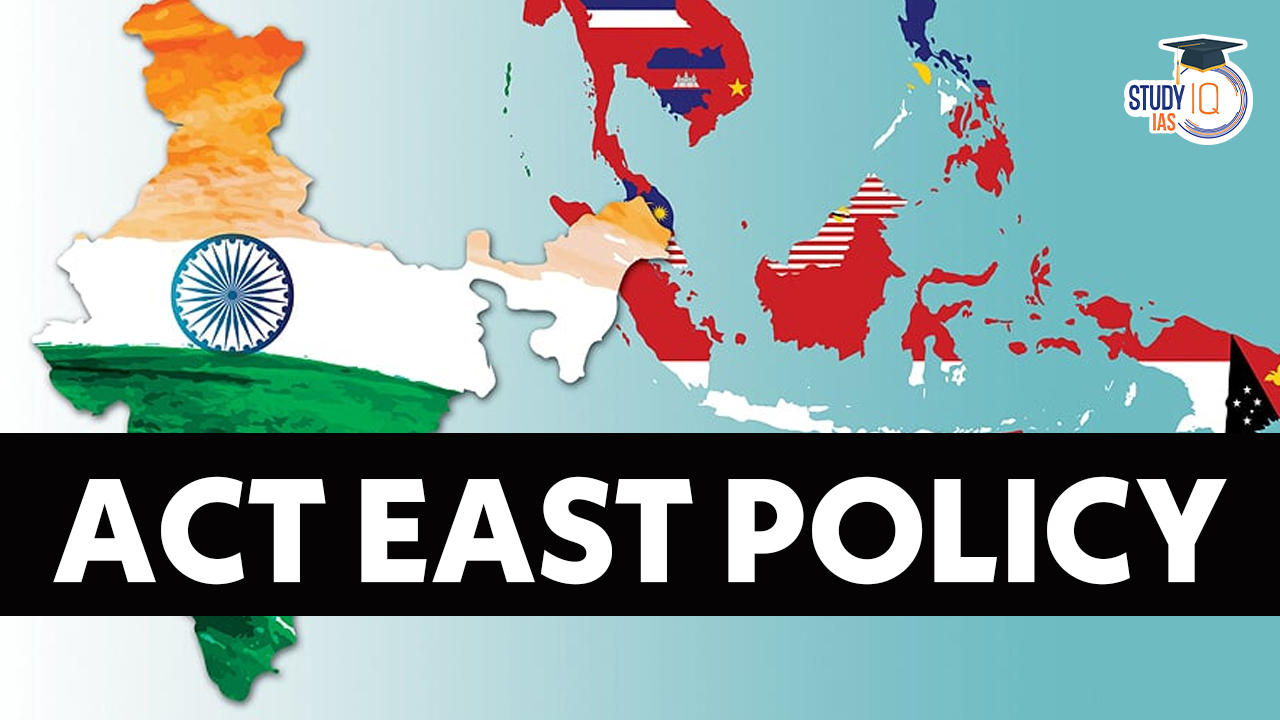Table of Contents
Act East Policy: The “Act East Policy” is a revision to the “Look East Policy,” which was introduced in November 2014. It is a diplomatic initiative to advance all levels of economic, geopolitical, and cultural ties with the large Asia-Pacific region. It entails extensive and ongoing interaction with Southeast Asian nations at the bilateral, regional, and international levels in the areas of connectivity, trade, culture, defence, and interpersonal relations.
The ‘Act East Policy’ of India is a diplomatic strategy to deepen diplomatic, strategic, and cultural links with the vast Asia-Pacific area at various levels. At the 12th ASEAN-India Summit 2014, which was held in Myanmar in November 2014, the Act East Policy was unveiled. The Look East Policy, which was put into effect in 1992, has been replaced by the Act East Policy. Act East, in contrast to Look East, which focuses on economic engagement with ASEAN countries, includes security cooperation as well as regional cooperation.
Look East Policy of India
India’s Look East policy seeks to forge extensive economic and strategic ties with Southeast Asian nations to enhance its position as a regional force and a counterbalance to the People’s Republic of China’s significant influence.
- It was developed and adopted by the government of Prime Minister Narasimha Rao (1991–1996) and strictly continued by the succeeding administrations of Atal Bihari Vajpayee (1998–2004) and Manmohan Singh (2004–2014), marking a significant shift in India’s perspective on the world.
- The results of the Look East strategy inspired the Mandarins of South Block to make it better by making it more result-based and action-oriented.
- The Indian administration of Prime Minister Narendra Modi introduced the Act East Policy in 2014, and it has since emerged as the Look-East Policy’s successor.
Act East Policy
Act of India A foreign policy endeavour is called East Policy. It aspires to increase East Asian and Southeast Asian nations’ economic and geopolitical connections with India. The 2014-launched approach is centred on forming alliances with other nations. Members of the Association of Southeast Asian Nations (ASEAN) as well as Japan and South Korea are among the nations. It seeks to advance regional security cooperation and economic integration.
- The Act East Policy seeks to improve ties between the neighbouring countries and the northeastern states, particularly Arunachal Pradesh.
- It began as an economic policy but has since expanded to incorporate strategic, political, and cultural elements.
- Under this policy, institutionalised channels for communication and collaboration were created.
- The policy emphasises India-ASEAN collaboration on domestic projects. This covers manufacturing, trade, infrastructure, and smart cities.
- Major projects under the policy include:
- the India-Myanmar-Thailand Trilateral Highway Project,
- Kaladan Multi-modal Transit Transport Project,
- Rhi-Tiddim Road Project, and
- Border Haats.
Act East Policy Importance
The Act East Policy is strengthened by China’s growing sway in Southeast Asia and the Indian Ocean, and it has the potential to safeguard freedom of navigation and the rule of law in the Indo-Pacific region. China’s rising influence and the end of the Cold War have altered Indo-ASEAN ties, and India’s participation in QUAD is a continuation of its attempts to strengthen security in the Indo-Pacific region. But it’s anticipated that these ties will only get stronger as a result of business partnerships and security collaboration. India’s Act East Policy seeks to advance India’s long-term development objectives for the Northeastern region. It offers a different route to speed up economic development, fending against China’s escalating assertiveness in South Asia.
Act East Policy Initiative
- The rail link that connects Bangladesh and India at Agartala.
- Bangladesh-based inland waterways and intermodal transportation linkages.
- Kaladan Multimodal Transit Transport Project – The connectivity between the landlocked northeastern states and the Rakhine state of Myanmar is thought to be greatly aided by the Kaladan transport project.
- The Trilateral Highway Project, which links Thailand, Myanmar, and the North East.Road and bridge projects as well as the upgrading of hydroelectric power plants have been done under the India-Japan Act East Forum.
- The commissioning of the three Ro-pax vessels operating between Dhubri and Hatsingimari, North Guwahati and South Guwahati, and Neamati-Majuli island will serve as a milestone for the opening of the Mahabhu-Brahmaputra inland canal programme..
- Dhubri Phulbari bridge – The foundation stone for a 19-km-long four-lane Dhubri Phulbari bridge over the Brahmaputra river. It will be India’s longest bridge work over a river, connecting Dhubri in Assam and Phulbari in Meghalaya, built at a cost of Rs 5,000 crores.
Act East Policy Progress
The progress made by the Act East Policy has been given below:
ASEAN Engagement
India is currently ASEAN’s fourth-largest commercial partner, and Southeast Asian countries help India in order to resist China’s expansionist policies. For connectivity, India has allocated $1 billion during the India-ASEAN summit.
Cooperation on Regional Initiatives
India is leading sub-regional programs and projects, including the following: BBIN corridor, Kaladan multimodal project, Myanmar-Thailand Trilateral Highway, etc.
Development of the North-East
The Northeast is the primary focus of the Act East Policy. Japan has pledged to invest Rs 13,000 crore in both new and ongoing projects in the area. In 2017, the India-Japan Act East Forum was established. A 2+2 Ministerial Dialogue has been formalised between Japan and India.
Security Engagement
- Defence cooperation with East Asian countries has increased.
- In 2014, an MoU was struck between India and Vietnam to purchase defence supplies from India.
- Institutional connections exist between Japan and South Korea and India.
- India has participated in joint military drills and maritime law enforcement patrols with ASEAN countries.
Far East Engagement
Russia and other economies in the Far East have been contacted by India. India has declared that it will open a credit line of $1 billion USD for the development of the Russian Far East.
Act East policy Latest Project
For a period of five years, from 2020–2021 to 2024–2025, the Government of India sanctioned projects for inland water transport (IWT) infrastructure on national waterways in the North–Eastern Region (NER).
- The Comprehensive Project for the Development of National Waterway (NW)-2 will enable access by water to the ports of Haldia and Kolkata in the North East via the Indo-Bangladesh Protocol Route. The construction of the Jogighopa Terminal, an alternative route to the Pandu Port, a ship repair facility, and tourist jetties at Biswanathghat, Jogighopa, Pandu, and Neamati are the project’s main interventions.
- Action has been initiated to modernise the Badarpur and Karimganj terminals, including the customs and immigration facilities at the Karimganj port, as part of the comprehensive project for the development of the NW-16 & IBP route. The construction of a terminal at Sonamura on the Gumti River, the construction of a terminal at Maia on the Ganga River, and the upgrading of the terminals in Badarpur and Karimganj are the project’s main projects.
Difference between Act East Policy and Look East Policy
In the development of India’s strategy towards South East Asia and East Asia, both of these policies represent two subsequent phases. The table below lists some of the key distinctions between India’s “Act East” and “Look East” policies.
| Act East Policy | Look East Policy |
| Act East Policy was launched in 2014 | Look East Policy was launched in 1991 |
| It was launched by the Current Prime Minister of India Narendra Modi | It was launched by former Prime Minister of India PV Narasimha Rao |
| When the Act East Policy was introduced in 2014, India was in a very advantageous position in terms of economic might. | Due to the 1991 Economic Crisis, India’s economy was extremely vulnerable when the Look East Policy was introduced. India was in the process of liberalising its economy. |
| The emphasis is more on strengthening strategic and security relations, infrastructure development for better connectivity, and fostering economic cooperation. | Focus more on boosting economic co-operation. |
| This initiative was made in response to the shifting geopolitical environment brought on by China’s supremacy in the South China Sea and its growing influence in the Indian Ocean region. | The Soviet Union was a major factor in the Indian economy, but after the fall of the Soviet Bloc, India was forced to explore elsewhere for economic support, leading it to South East Asia. As China and Japan had already established themselves as significant economic powers in the region, India saw the enormous potential for growth in the area. |
| The partnership in Act East Policy has a stronger strategic and political angle. To oppose China’s hegemony in the entire region, relations with Japan, South Korea, Vietnam, Malaysia, and Australia have been elevated to a strategic alliance. | The promotion of business and investment ties with Southeast Asian nations was the main focus. The Quad of Australia, Japan, the United States, and India was not given much attention, nor was the strategic alliance with other countries in the region upgraded. |
| Putting more of an emphasis on shared linguistic, historical, and religious traditions by increasing intercultural dialogue. | India’s Look East Policy did not emphasise the historical linkages between India and ASEAN enough or capitalise on them. |
| The development of the North East region is being given considerable attention. India thinks its north-eastern area has the potential to serve as a bridge to Southeast and East Asia. By contributing funding for numerous infrastructure projects, Japan is assisting India. | North East of India was neglected in its plans of forging deeper ties with East Asia. |
| India is collaborating with Japan in developing infrastructure in Sri Lanka, Myanmar, and Bangladesh | India did not focus on developing infrastructure in other countries. |
| Greater focus on defense cooperation | Not much focus on defense cooperation |
The following is a list of some similarities between the Act East Policy of 2014 and the Look East Policy of 1991.
- Economic Common Interests
- Similar Strategic Objectives


 UPSC CDS Result 2024 Expexted Soon
UPSC CDS Result 2024 Expexted Soon
 Time Table for UPSC Preparation, 1 Year ...
Time Table for UPSC Preparation, 1 Year ...
 UPSC Preparation 2025, Check One Year Pl...
UPSC Preparation 2025, Check One Year Pl...

















